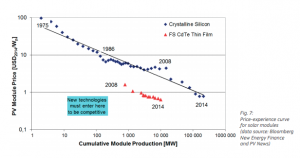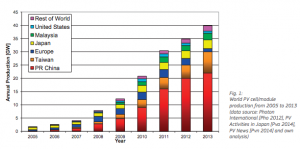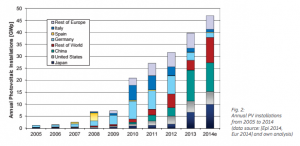Various organizations have attempted to articulate likely future scenarios following guidelines/recommendations involving increased R&D and competitiveness in the energy market via regional, national and international policy.
The International Energy Agency projects:
- significant long-term growth worldwide
- by 2050, PV will represent 11% of global electricity production. [2]
Enabling “growth in regions new to solar energy may present cost and institutional challenges that would require active management; institutional and technical knowledge transfer from those regions that are already witnessing substantial solar energy activity may be required.” [3]
As manufacturing costs, installation costs and LCOE continue to decrease while production increases, solar pv’s share in global energy production can be expected to increase. The following figures show the current international and domestic trends, which show a correlation between increased production/installation and decreased installation price:

Figure 3: Price-experience curve exhibiting decrease installation prices with increased production [1]
Author: Kevin Jackson
Editor: Abby Studen, Hannah Goldstein
Sources:
[1] Jäger-Waldau, A., (2014). PV Status Report 2014. European Commission, DG Joint Research Centre, Institute for Energy and Transport, Renewable Energy Unit Via Enrico Fermi 2749, TP 450 I – 21027, Ispra (VA), Italy
[2] International Energy Agency. (2010). Technology Roadmap: Solar photovoltaic energy.
[3] Intergovernmental Panel on Climate Change. (2011). IPCC Special Report on Renewable Energy Sources and Climate Change Mitigation. Prepared by Working Group III of the Intergovernmental Panel on Climate Change [O. Edenhofer, R. Pichs-Madruga, Y. Sokona, K. Seyboth, P. Matschoss, S. Kadner, T. Zwickel, P. Eickemeier, G. Hansen, S. Schlömer, C. von Stechow (eds)]. Cambridge University Press, Cambridge, United Kingdom and New York, NY, USA, 1075 pp.

